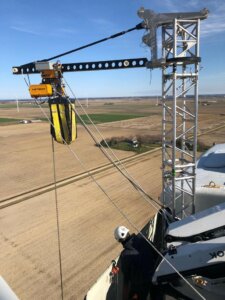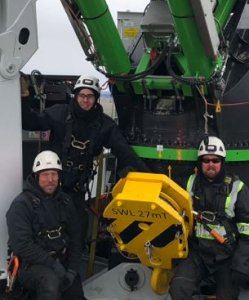
Staying safe during up-tower lifting
In the first of a series of articles dedicated to safe lifting in de logistics sector, Hubert Boter, senior project engineer at Netherlands-headquartered Eager.one, considers the challenges of working at height – specifically, the demands of servicing onshore wind turbines.
Have you ever considered that it is possible to work in a confined space but have the opportunity to enjoy the best view of your life – 360 degrees around as far as you can see?
That is possible when you are a wind turbine technician, tasked with working in the nacelle of a turbine replacing yaw motors, gearboxes, generators and other critical components.
Up-tower lifting is an emerging market and requires highly specific equipment that combines complex engineering with the demands of limited space and health and safety requirements.
The process starts by preparing the nacelle for the components exchange. Covers, panels and lids are opened or removed, depending on the manufacturers’ specifications, among other prescribed tasks.
Crane foundation
Smaller parts are lifted through the tower or through a hatch at the rear of the nacelle. These parts are moved by hand and assembled into a small crane foundation. After opening the roof using handheld tools, a crane is built out of lightweight components on top of the foundation. When installed, a function test is performed and the technician is ready for the first lift.
Components weighing up to 800 kg (0,8 tons), such as yaw motors, can now be exchanged. A component is lifted from its location in the nacelle, slewed over the edge and lowered to the ground. The new items are installed. If heavier components need to be removed and exchanged, the crane is used to lift the parts required for a larger crane foundation.
This foundation is mounted on the strong points of the bed frame. A larger crane can then be lifted up-tower and installed on this new build base. Thereafter, a power pack and an electric chain hoist with a chain bag are lifted and installed on the second crane. Everything is connected and function tested.
This crane has a maximum lift capacity of 2,9 tons and is capable of removing a complete nacelle roof, opening a gearbox, exchanging a helical gear or intermediate shaft (IMS), etc.
Extra capacity
If this second crane is still short on capacity, there is the possibility to install an even larger crane that can lift gearboxes and generators.
This crane consist of four major parts that clicks together like Lego. Everything is hydraulically and electrically connected, and a third function test will take place. This largest crane is capable of performing a gearbox or generator exchange. The maximum capacity is 27 tons at a reach of 3.75 m. Maximum outreach is 7 m.
When the component is replaced, the cranes can be demobilized in the inverse sequence to how they were assembled.
Understandably, it can become quite crowded in the nacelle and it is extremely important to be aware that something may go wrong.
In an emergency situation, workers may need to abandon or evacuate the nacelle. A technician may have been injured up-tower and require immediate evacuation. Or, a dangerous situation may have arisen, forcing everybody to leave the turbine.
The area where technicians work is classified as a confined space, or ‘zone 1’, according to industry specifications. There is normally one exit in the nacelle – it is the way you came in, which is through the tower.
Alternative routes include:
- Escape to the roof
- Service hatch at the back of the nacelle and descent
- Leave the nacelle over the edge or the hub and descent to the ground
It should be noted that an escape to the roof is only feasible if a technician can be picked up by helicopter.
The service hatch in the floor of the nacelle is another possible escape route, with the technician using a descent system to reach ground level.
Every wind turbine has evacuation instructions drafted by the turbine manufacturer. These instructions describe procedures for an emergency. A descent should be carries out with care and while using a full fall arrest system.
Evacuation of an injured co-worker can be executed in two different ways – either horizontally or vertically.
Vertical evacuation is when the patient is able to use the normal descent methods, either alone or with help, or when the patient may be suspended vertically during rapid lowering from the nacelle or from the tower ladder. Horizontal evacuation is undertaken when the patient has an injury that would be life-threatening if evacuation took place in an upright position. The patient must lie in horizontal position during the entire evacuation, ruling out certain escape routes (which differ from turbine to turbine).
As up-tower lifting technology increases in prominence, mechanical, electrical and hydraulic engineering will advance too.
Nevertheless, an important aspect of both turbine and lifting equipment design must be safety. Technicians must always keep the safety aspects of working at height and working in a confined space in mind. And, when you are up-tower, take a moment and enjoy the view.
The content of this article is intended to provide a general guide to the subject matter. Please contact us for specialist advice about your specific circumstances.
This article was also published in the July/August edition of HLPFI magazine. Read the online version here.
Interested to learn about new techniques for onshore wind maintenance?
Visit our Masterclass ‘Installation and maintenance in the onshore wind industry’ and learn all ins & outs on installation of onshore wind farms using large cranes with a focus on the preparation of the operations and the job site.
Upcoming events
What we do
As an independent partner, we advise about, design and construct everything from concept study to project completed. Our in-house developed design software calculates everything concerning mobile cranes and bespoke heavy equipment, while our people offer the expertise and skills that secure your success.
GET YOUR PROJECT PREPARED
Consultancy / Design & Construction
Our 40 years of experience provides the basis of a successful start of your project: right from the FEED phase. Preparation is vital. Therefore our concept studies, method statements and mission equipment offer you all the support you need.
GET YOUR PROJECT EXECUTION SUPPORTED
Consultancy / Design & Construction
Our aim is to optimize your project team’s results. With our exclusive knowledge of lifting and transportation we eliminate and manage risks. This is how we reach our collective goal: Zero Accidents, Zero Incidents.
DESIGN OF LIFTING & TRANSPORT ASSETS
Engineering
We have built up a great deal of experience with the design of (mobile) cranes and bespoke heavy equipment such as piling machines and excavators. Our customer base includes the most prominent producers of cranes and heavy machinery worldwide.
We are eager to hear from you
Call +31 (0) 30 240 80 60 or use the contact form. We always respond within 24 hours.


